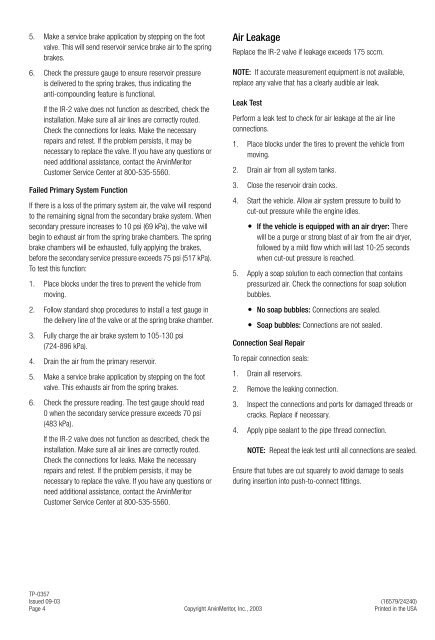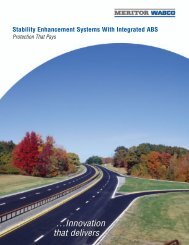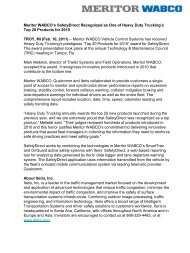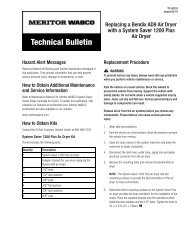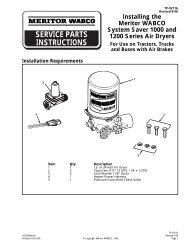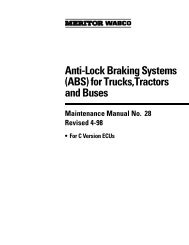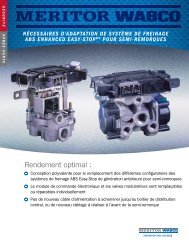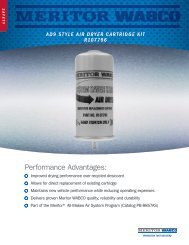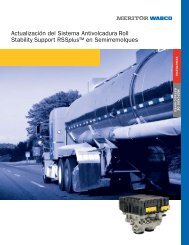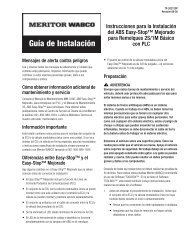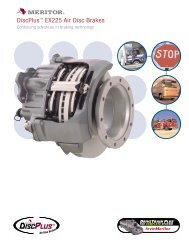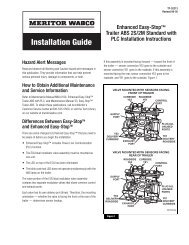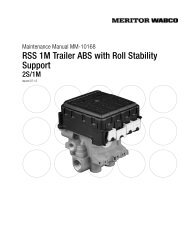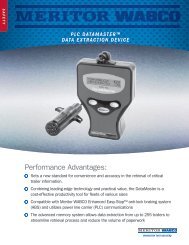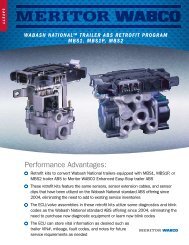IR-2 - Meritor WABCO
IR-2 - Meritor WABCO
IR-2 - Meritor WABCO
Create successful ePaper yourself
Turn your PDF publications into a flip-book with our unique Google optimized e-Paper software.
5. Make a service brake application by stepping on the foot<br />
valve. This will send reservoir service brake air to the spring<br />
brakes.<br />
6. Check the pressure gauge to ensure reservoir pressure<br />
is delivered to the spring brakes, thus indicating the<br />
anti-compounding feature is functional.<br />
If the <strong>IR</strong>-2 valve does not function as described, check the<br />
installation. Make sure all air lines are correctly routed.<br />
Check the connections for leaks. Make the necessary<br />
repairs and retest. If the problem persists, it may be<br />
necessary to replace the valve. If you have any questions or<br />
need additional assistance, contact the Arvin<strong>Meritor</strong><br />
Customer Service Center at 800-535-5560.<br />
Failed Primary System Function<br />
If there is a loss of the primary system air, the valve will respond<br />
to the remaining signal from the secondary brake system. When<br />
secondary pressure increases to 10 psi (69 kPa), the valve will<br />
begin to exhaust air from the spring brake chambers. The spring<br />
brake chambers will be exhausted, fully applying the brakes,<br />
before the secondary service pressure exceeds 75 psi (517 kPa).<br />
To test this function:<br />
1. Place blocks under the tires to prevent the vehicle from<br />
moving.<br />
2. Follow standard shop procedures to install a test gauge in<br />
the delivery line of the valve or at the spring brake chamber.<br />
3. Fully charge the air brake system to 105-130 psi<br />
(724-896 kPa).<br />
4. Drain the air from the primary reservoir.<br />
5. Make a service brake application by stepping on the foot<br />
valve. This exhausts air from the spring brakes.<br />
6. Check the pressure reading. The test gauge should read<br />
0 when the secondary service pressure exceeds 70 psi<br />
(483 kPa).<br />
If the <strong>IR</strong>-2 valve does not function as described, check the<br />
installation. Make sure all air lines are correctly routed.<br />
Check the connections for leaks. Make the necessary<br />
repairs and retest. If the problem persists, it may be<br />
necessary to replace the valve. If you have any questions or<br />
need additional assistance, contact the Arvin<strong>Meritor</strong><br />
Customer Service Center at 800-535-5560.<br />
Air Leakage<br />
Replace the <strong>IR</strong>-2 valve if leakage exceeds 175 sccm.<br />
NOTE: If accurate measurement equipment is not available,<br />
replace any valve that has a clearly audible air leak.<br />
Leak Test<br />
Perform a leak test to check for air leakage at the air line<br />
connections.<br />
1. Place blocks under the tires to prevent the vehicle from<br />
moving.<br />
2. Drain air from all system tanks.<br />
3. Close the reservoir drain cocks.<br />
4. Start the vehicle. Allow air system pressure to build to<br />
cut-out pressure while the engine idles.<br />
If the vehicle is equipped with an air dryer: There<br />
will be a purge or strong blast of air from the air dryer,<br />
followed by a mild flow which will last 10-25 seconds<br />
when cut-out pressure is reached.<br />
5. Apply a soap solution to each connection that contains<br />
pressurized air. Check the connections for soap solution<br />
bubbles.<br />
No soap bubbles: Connections are sealed.<br />
Soap bubbles: Connections are not sealed.<br />
Connection Seal Repair<br />
To repair connection seals:<br />
1. Drain all reservoirs.<br />
2. Remove the leaking connection.<br />
3. Inspect the connections and ports for damaged threads or<br />
cracks. Replace if necessary.<br />
4. Apply pipe sealant to the pipe thread connection.<br />
NOTE: Repeat the leak test until all connections are sealed.<br />
Ensure that tubes are cut squarely to avoid damage to seals<br />
during insertion into push-to-connect fittings.<br />
TP-0357<br />
Issued 09-03 (16579/24240)<br />
Page 4 Copyright Arvin<strong>Meritor</strong>, Inc., 2003 Printed in the USA


